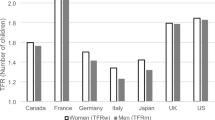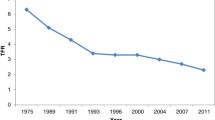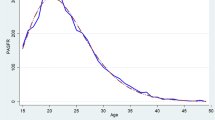Abstract
In this study, a simple analytical framework to find the probability distributions of number of children and maternal age at various order births by making use of data on age-specific fertility rates by birth order was proposed. The proposed framework is applicable to both the period and cohort fertility schedules. The most appealing point of the proposed framework is that it does not require stringent assumptions. The proposed framework has been applied to the cohort birth order-specific fertility schedules of India and its different regions and period birth order-specific fertility schedules, including the United States of America, Russia, and the Netherlands, to demonstrate its usefulness.



Similar content being viewed by others
Notes
Strict assumptions in the Dandekar model (Dandekar, 1955) include: (1) each conception will result in a live birth, (2) probability of a conception in a trail (a menstrual cycle) is constant and does not change from one trail to another, and (3) there will be no conception in the next ‘m’ months (‘m’ is a fixed constant) once there is conception in a month. We consider these to be strict assumptions because (1) not all conceptions will result in live births, (2) the scope of a non-pregnant woman to conceive in any month is not constant and depends on many factors, such as the occurrence of the menstrual cycle in that particular month, intercourse between couples and its frequency with regard to ovulation, usage of contraception, and the health condition of the couple, and (3) the rest period between conception and the next conception need not be a fixed constant and generally depends upon a number of other factors.
Pandey and Suchindran (1997) have used vital rates to derive the distribution of maternal age at various order births, birth intervals, and the PPRs. Krishnamoorthy (1979) and Suchindran and Horne (1984) have derived the distribution of maternal age at first and last births by modifying the work of Hoem (1970) who developed models to study transition probabilities from a specific parity to the next higher parity.
In the case of twin births, we have randomly taken one of the two births as the ith order birth and the other as the (i+1)th order birth. This way of considering birth orders may distort the timing of birth of various order births to which they correspond, for any considered cohort (real or synthetic). However, as twin births are rare (roughly one in 240 births as per our exploration of the Third National Family Health Survey data), the above issue is not a serious problem in reality.
Let there be N women in our considered cohort. As introduced earlier, let \(B_{i}^{j} \) indicate the event of ever occurrence of the i th order birth to the j th individual of our cohort. So, basically, \(B_{i}^{j}\) is a binary event taking values either zero or one. Hence, some B i js are zeros and some B i js are ones, depending upon the occurrence of the i th order birth to the corresponding individuals. In this case, the total number of women who give an i th order birth is \(\sum _{j=1}^{N}B_{i}^{j} \) . Hence, the proportion of women who give an i th order birth is \({\sum _{j=1}^{N}B_{i}^{j} }/{N} \), which is the same as the average number of i th order births to the women of our considered cohort.
Parity is the number of children a woman has already had. PPR is the probability that a woman with a particular parity to progress to the next parity. For example, if a woman has already had three children, it is the probability of her having the fourth.
Primary infertility level means the biological inability of couples to have at least one child in their life, despite their wish to have children. As the desire for children is universal in India (only 0.1% of married women reported their ideal number of children as zero, i.e., one in 1,000 women do not want any children (International Institute for Population Sciences and Macro International, 2007)), so, almost all couples who do not have children during their life can be treated as primary infertile (although most of these may have had children if proper treatment had been provided).
The registration of vital events is almost complete in all the countries that have been covered in HFD. Therefore, the sample size of women aged ‘x’ years is same as the corresponding population size of women aged ‘x’ years for all the countries that are covered in HFD.
References
Bhattacharya, B.N. and Nath, D.C. (1985). On some bivariate distributions of number of births. Sankhya, 47, 372–384.
Bhattacharya, B.N., Singh, K.K., Singh, U. and Pandey, C.M. (1989). An extension of a model for first birth interval and some social factors. Sankhya, 51, 115–124.
Bongaarts, J. and Feeney, G. (1998). On the quantum and tempo of fertility. Popul. Dev. Rev., 24, 271–291.
Bongaarts, J. and Greenhalgh, S. (1985). An alternative to the one-child policy in China. Popul. Dev. Rev., 11, 585–617.
Chandola, T., Coleman, D.A. and Horns, R.W. (1999). Recent European fertility patterns: fitting curves to ’distorted’ distributions. Pop. Stud.-J. Demog., 53, 317–329.
Cleland, J.G. and Sathar, Z.A. (1984). The effect of birth spacing on childhood mortality in Pakistan. Pop. Stud.-J. Demog., 38, 401–418.
Curtis, S., Diamond, I. and Mcdonald, J. (1993). Birth interval and family effects on postneonatal mortality in Brazil. Demography, 30, 33–43.
Dandekar, V.M. (1955). Certain modified forms of binomial and Poison distributions. Sankhya, 15, 237–250.
Frejka, T. (1973). The future of population growth: alternative paths to equilibrium. John Wiley and Sons, New York.
Hadwiger, H. (1940). Eine analytische reprodutions-funktion fur biologische Gesamtheiten. Skandinavisk Aktuarietidskrift, 23, 101–113.
Hoem, J.M. (1970). Probabilistic fertility models of life table type. Theor. Popul. Biol., 1, 12–38.
Hoem, J.M. and Erling B. (1975). Some problems in Hadwiger fertility graduation. Scand. Actuar. J., 129–144.
Hoem, J.M., Madsen, D., Nielsen, J.L., Ohlsen, E.-M., Hansen, H.O. and Rennermalm, B. (1981). Experiments in modeling recent Danish fertility curves. Demography, 18, 231–244.
International Institute For Population Sciences And Macro International (2007). National Family Health Survey (NFHS-3), 2005-06: India: Volume I, Mumbai: IIPS.
King, J.C. (2003). The risk of maternal nutritional depletion and poor outcomes increases in early or closely spaced pregnancies. J. Nutr., 133, 1732S–1736S.
Koenig, M.A., Phillips, J.F., Campbell, O.M. and D’Souza, s. (1990). Birth intervals and childhood mortality in rural Bangladesh. Demography, 27, 251–265. doi:10.2307/2061452.
Krishnamoorthy, S. (1979). Family formation and the life cycle. Demography, 16, 121–129.
Nath, D.C., Land, K.C. and Goswami, G. (1999). Effects of the status of women on the first birth interval in Indian urban society. J. Biosoc. Sci., 31(1), 55–69.
Nath, D.C., Singh, K.K., Land, K.C. and Talukdar, P.K. (1993). Age at marriage and length of first-birth interval in traditional Indian society: Life table and hazard model analysis. Hum. Biol., 65, 783–797.
Newell, C. (1988). Methods and models in demography. Wiley, Chichester.
Nurul, A. (1995). Birth spacing and infant and early childhood mortality in a high fertility area of Bangladesh: age-dependent and interactive effects. J. Biosoc. Sci., 27, 393–404. doi:10.1017/S0021932000023002.
Pandey, A. and Suchindran, C.M. (1995). Some analytical models to estimate ma ternal age at birth using age-specific fertility rates. Sankhya, 57, 142–150.
Pandey, A. and Suchindran, C.M. (1997). Estimation of birth intervals and parity progression rations from vital rates. Sankhya, 59, 108–122.
Pasupuleti, S.S.R. and Pathak, P. (2010). Special form of Gompertz model and its application. Genus, 66, 95–125.
Pathak, K.B. (1970). A time dependent distribution for number of conceptions. Artha Vijnana, 12, 429–435.
Pathak, K.B. (1999). Stochastic models of family building: an analytical review and prospective issues. Sankhya, 61, 237–260.
Pathak, K.B. and Pandey, A. (1993). Stochastic models of human reproduction. Himalaya Publishing House, Bombay.
Peristera, P. and Kostaki, A. (2007). Modeling fertility in modern populations. Demogr. Res., 16, 141–194.
Perrin, E.B. and Sheps, M.C. (1964). Human reproduction: a stochastic process. Biometrics, 20, 28–45.
Shalakani, M.E. and Pandey, A. (1989). Distribution of births in an abrupt sequence: a stochastic model. Math. Biosci., 95, 1–11.
Singh, S.N. (1963). Probability models for the variation in the number of births per couple. J. Amer. Statist. Assoc., 58, 721–727.
Singh, S.N. (1964). On the time of first birth. Sankhya, 26, 95–102.
Singh, S.N., Bhattacharya, B.N. and Yadava, R.C. (1974). A parity dependent model for number of births and its application. Sankhya, 36, 93–102.
Singh, V.K. and Singh, U.N. (1983). Period of temporary separation and its effect on first birth interval. Demography India, 12, 282–88.
Suchindran, C.M. and Horne, A.D. (1984). Some Statistical Approaches to the Modelling of Selected Fertility Events. In Proceedings of American Statistical Association (Social Statis tics Section). Washington DC, pp. 629–634.
Rajaretnam, T. (1990). How delaying marriage and spacing births contributes to population control? An explanation with illustrations. J. Fam. Welfare, 36(4), 3–13.
Rousso, D., Panidis, D., Gkoutzioulis, F., Kourtis, A., Mavromatidis, G. and Kalahanis, I. (2002). Effect of the interval between pregnancies on the health of mother and child. Eur. J. Obstet. Gyn. R. B., 105, 4–6.
Wald, A. (1947). Sequential analysis. John Wiley & Sons, Inc., New York.
Acknowledgement
We gratefully acknowledge the anonymous referees for their constructive comments on an earlier version of this paper.
Author information
Authors and Affiliations
Corresponding author
Appendices
Appendix A
Appendix B
Proof of Lemma.
Moment Generating Function (MGF)
Taking x − m/σ 1 = z 1 and x − m/σ 2 = z 2 , the above expression can be rewritten as
By taking z 1 − tσ 1 = y 1 and z 2 − tσ 2 = y 2 it can be shown that the above expression is equal to
where Φ(x) is the cumulative probability distribution function of standard normal distribution.
Mean
Using the result
it is possible to show that
Variance
Proceeding in the same way as was done previously, it can be shown that
and
It can also be shown that
and
Rights and permissions
About this article
Cite this article
Pasupuleti, S.S.R., Chattopadhyay, A.K. Probability distributions of number of children and maternal age at various order births using age-specific fertility rates by birth order. Sankhya B 75, 374–408 (2013). https://doi.org/10.1007/s13571-012-0054-z
Received:
Revised:
Published:
Issue Date:
DOI: https://doi.org/10.1007/s13571-012-0054-z
Keywords and phrases.
- Wald model
- Peristera Kostaki model
- parity progression ratio
- Total Fertility Rate
- fertility models
- maternal age at birth
- variance of fertility distribution







